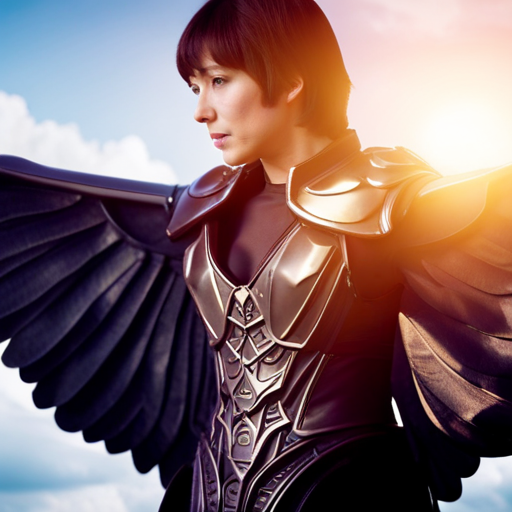Crafting Realistic Armor and Weaponry for Costumes

In a world of fantastical costumes, the key to crafting truly immersive armor and weaponry lies in the art of paradox.
The marriage of authenticity and creativity is the cornerstone of bringing these designs to life. From the careful selection of materials to the intricate assembly and finishing techniques, this article offers a comprehensive guide to crafting realistic armor and weaponry that not only looks the part but also ensures comfort and mobility for the wearer.
Choosing the Right Materials
When choosing materials for crafting realistic armor and weaponry for costumes, it is essential to select high-quality, durable, and authentic options to ensure an accurate and professional-looking final product. Material durability and weight are crucial factors to consider.
For armor, materials such as high-density foam, thermoplastics like Worbla, or even fiberglass offer the durability needed for costumes that will be worn multiple times without sacrificing authenticity. These materials also come in varying weights, allowing for comfort during wear.
When it comes to weaponry, materials like EVA foam and PVC pipes provide a balance of durability and weight, making them suitable for crafting realistic-looking swords, shields, and other props.
Authenticity is key to creating a convincing costume, but affordability should not be overlooked. While authentic materials such as leather and metal can be expensive, there are affordable alternatives that still offer a realistic look. Faux leather, craft foam, and various paints and finishes can be used to achieve an authentic appearance without breaking the bank.
Creating Authentic Designs
To create authentic designs for realistic armor and weaponry in costumes, meticulous attention to detail and historical accuracy is essential. When considering historical accuracy, it is crucial to research and understand the design elements of armor and weaponry from specific time periods and cultures. Each culture has its own unique design elements and craftsmanship techniques that hold cultural significance.
For instance, Japanese samurai armor features intricate lacing and embossing, reflecting the craftsmanship techniques of its time. Understanding these cultural nuances is integral to creating authentic designs that accurately represent the armor and weaponry of a particular era or civilization.
Incorporating historical accuracy into costume designs involves delving into the cultural significance of the armor and weaponry being represented. This may include understanding the symbolic meanings behind certain embellishments or the functional aspects of the design. By studying historical artifacts and texts, costume designers can gain insights into the craftsmanship techniques employed by ancient artisans, allowing them to replicate these details authentically in their designs.
Ultimately, meticulous attention to historical accuracy and an understanding of design elements and craftsmanship techniques are essential for creating truly authentic armor and weaponry for costumes.
Assembling and Finishing Techniques
Continuing the exploration of crafting realistic armor and weaponry for costumes, the process of assembling and finishing techniques plays a crucial role in achieving an authentic representation of historical and cultural artifacts. When it comes to creating realistic armor and weaponry for costumes, the assembling and finishing techniques are just as important as the design itself.
Here are three key components to consider for achieving an authentic look:
-
Weathering Techniques and Painting Methods: Applying weathering techniques such as dry brushing, washes, and airbrushing can add depth and realism to the costume pieces. Utilizing painting methods that mimic the look of aged and worn materials can further enhance the overall appearance.
-
Aging Effects and Distressing Process: Incorporating aging effects such as rust, tarnishing, and patina can give the armor and weaponry a sense of history and character. The distressing process, which involves techniques like sanding, scratching, and adding dents, helps to create a worn and battle-tested appearance.
-
Sealing and Protecting: After applying the desired finishing techniques, it’s crucial to seal and protect the costume pieces to ensure the longevity of the finish. Using clear coats or sealants can safeguard the realistic appearance while also providing durability.
Adding Functional Elements
The process of adding functional elements to realistic armor and weaponry for costumes involves incorporating design features that serve practical purposes, enhancing the overall authenticity and usability of the costume pieces.
When considering how to incorporate movement into the design, it’s essential to ensure that the armor allows for a full range of motion. This can be achieved through strategic articulation points, such as hinged joints, to allow the wearer to move comfortably while maintaining the appearance of a solid, unbroken armor surface.
Practical embellishments, such as adjustable straps and buckles, are crucial for ensuring a secure and comfortable fit. These elements not only contribute to the functionality of the costume but also enhance the overall appearance by adding realistic details.
Additionally, integrating hidden pockets or pouches into the design can provide convenient storage for small essentials without compromising the costume’s aesthetic.
Furthermore, considering the weight distribution of the armor and weaponry is important to prevent strain or discomfort for the wearer. By strategically placing heavier elements and incorporating supportive structures, the costume can be made more comfortable and easier to wear for extended periods. These functional elements not only elevate the realism of the costume but also prioritize the practical needs of the wearer.
Ensuring Comfort and Mobility
When considering the incorporation of functional elements into realistic armor and weaponry for costumes, it is essential to prioritize ensuring the wearer’s comfort and mobility. This not only enhances the overall experience for the individual donning the costume but also contributes to the practicality and functionality of the attire.
Here are three key aspects to consider when aiming to achieve optimal comfort and mobility in costume armor and weaponry:
-
Improving flexibility: Incorporating materials and design elements that allow for a wide range of movement is crucial. Utilizing flexible fabrics, strategic joint articulation, and lightweight components can significantly enhance the wearer’s ability to move comfortably and freely.
-
Ensuring breathability: A well-ventilated costume can make a world of difference in the wearer’s comfort. Introducing breathable materials and incorporating ventilation points can help prevent overheating and discomfort during extended wear.
-
Balancing weight: Striking a balance between authenticity and practicality is important. By carefully distributing the weight of the armor and weaponry, the wearer can maintain agility and comfort without compromising the realistic aesthetic.
Frequently Asked Questions
How Can I Ensure That My Realistic Armor and Weaponry Comply With Convention or Event Safety Regulations?
To ensure compliance with event safety regulations, it is essential to incorporate safety measures and adhere to event guidelines. Familiarizing oneself with legal restrictions and seeking guidance from event organizers can help guarantee a safe and enjoyable experience for all attendees.
Are There Any Specific Legal Restrictions or Guidelines I Should Be Aware of When Creating Realistic Armor and Weaponry for Costumes?
When creating realistic armor and weaponry for costumes, it’s crucial to be mindful of legal restrictions and guidelines. Consider costume accuracy while ensuring safety compliance and adherence to event regulations for a successful and enjoyable cosplay experience.
What Are Some Tips for Transporting and Storing Realistic Armor and Weaponry to Prevent Damage?
When transporting realistic armor and weaponry, securing them in custom-fitted foam padding is like encasing them in a protective cocoon. For storage, consider using climate-controlled containers and regularly inspecting for wear and tear.
Are There Any Special Considerations for Cleaning and Maintaining Realistic Armor and Weaponry?
When it comes to cleaning and maintenance of realistic armor and weaponry, special considerations should be given to the material durability. Proper cleaning methods and regular inspections are essential to ensure longevity and preserve the integrity of the items.
How Can I Incorporate Special Effects, Such as Light-Up Elements or Sound Effects, Into My Realistic Armor and Weaponry Designs?
Incorporating special effects like light-up elements and sound effects into your designs adds a dynamic dimension. Light-up armor enhances visual impact, while sound effects in weaponry create an immersive experience, elevating the authenticity of your costume designs.
Conclusion
In conclusion, crafting realistic armor and weaponry for costumes requires careful consideration of materials, design, assembly, and functionality.
By incorporating authentic designs, functional elements, and ensuring comfort and mobility, costume creators can bring their characters to life in a visually striking and practical way.
For example, a costume designer may use lightweight yet durable materials to create a set of armor that allows the wearer to move freely and comfortably while maintaining a realistic appearance.

Rufus Whitver is a passionate costume artisan and the creative mind behind layuo.com. With a keen eye for detail and a flair for imaginative design, Rufus brings characters to life through the art of costume making. His expertise encompasses a wide range of styles, from historical recreations to fantastical creations. Through layuo.com, Rufus shares insights, tutorials, and a portfolio showcasing his exceptional craftsmanship, inspiring fellow enthusiasts to embark on their own journey into the world of stunning costumes.




